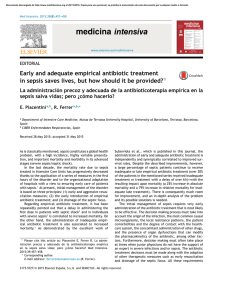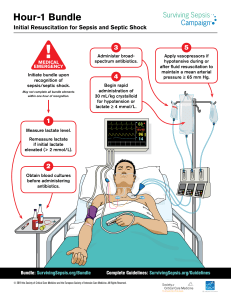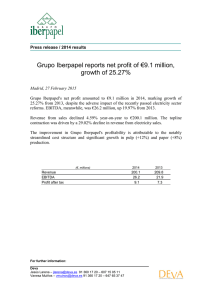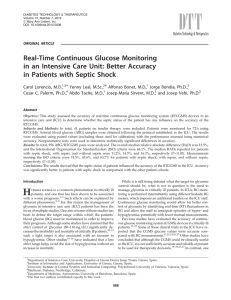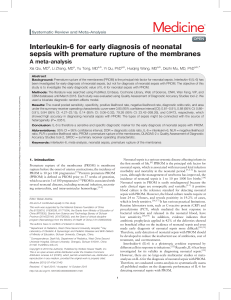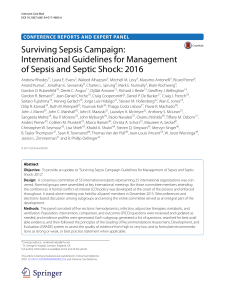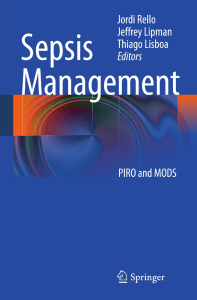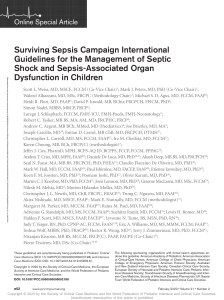Red blood cell distribution width changes in septic
Anuncio
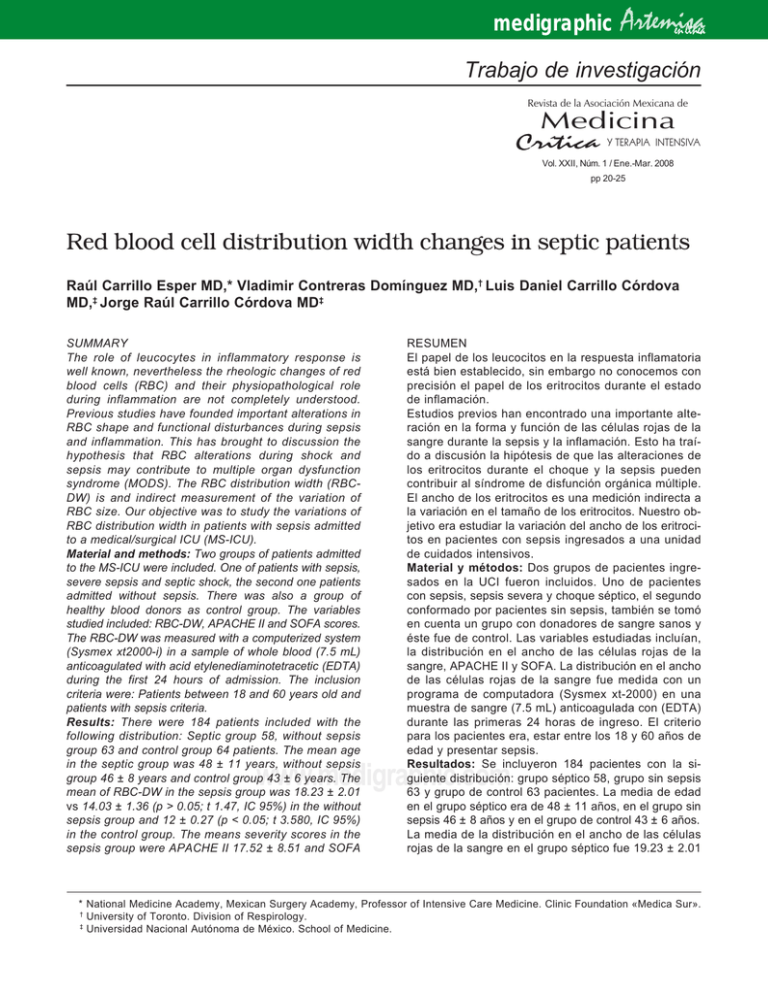
medigraphic Artemisa en línea Trabajo de investigación Revista de la Asociación Mexicana de Medicina Crítica Y TERAPIA INTENSIVA Vol. XXII, Núm. 1 / Ene.-Mar. 2008 pp 20-25 Red blood cell distribution width changes in septic patients Raúl Carrillo Esper MD,* Vladimir Contreras Domínguez MD,† Luis Daniel Carrillo Córdova MD,‡ Jorge Raúl Carrillo Córdova MD‡ SUMMARY The role of leucocytes in inflammatory response is well known, nevertheless the rheologic changes of red blood cells (RBC) and their physiopathological role during inflammation are not completely understood. Previous studies have founded important alterations in RBC shape and functional disturbances during sepsis and inflammation. This has brought to discussion the hypothesis that RBC alterations during shock and sepsis may contribute to multiple organ dysfunction syndrome (MODS). The RBC distribution width (RBCDW) is and indirect measurement of the variation of RBC size. Our objective was to study the variations of RBC distribution width in patients with sepsis admitted to a medical/surgical ICU (MS-ICU). Material and methods: Two groups of patients admitted to the MS-ICU were included. One of patients with sepsis, severe sepsis and septic shock, the second one patients admitted without sepsis. There was also a group of healthy blood donors as control group. The variables studied included: RBC-DW, APACHE II and SOFA scores. The RBC-DW was measured with a computerized system (Sysmex xt2000-i) in a sample of whole blood (7.5 mL) anticoagulated with acid etylenediaminotetracetic (EDTA) during the first 24 hours of admission. The inclusion criteria were: Patients between 18 and 60 years old and patients with sepsis criteria. Results: There were 184 patients included with the following distribution: Septic group 58, without sepsis group 63 and control group 64 patients. The mean age in the septic group was 48 ± 11 years, without sepsis group 46 ± 8 years and control group 43 ± 6 years. The mean of RBC-DW in the sepsis group was 18.23 ± 2.01 vs 14.03 ± 1.36 (p > 0.05; t 1.47, IC 95%) in the without sepsis group and 12 ± 0.27 (p < 0.05; t 3.580, IC 95%) in the control group. The means severity scores in the sepsis group were APACHE II 17.52 ± 8.51 and SOFA RESUMEN El papel de los leucocitos en la respuesta inflamatoria está bien establecido, sin embargo no conocemos con precisión el papel de los eritrocitos durante el estado de inflamación. Estudios previos han encontrado una importante alteración en la forma y función de las células rojas de la sangre durante la sepsis y la inflamación. Esto ha traído a discusión la hipótesis de que las alteraciones de los eritrocitos durante el choque y la sepsis pueden contribuir al síndrome de disfunción orgánica múltiple. El ancho de los eritrocitos es una medición indirecta a la variación en el tamaño de los eritrocitos. Nuestro objetivo era estudiar la variación del ancho de los eritrocitos en pacientes con sepsis ingresados a una unidad de cuidados intensivos. Material y métodos: Dos grupos de pacientes ingresados en la UCI fueron incluidos. Uno de pacientes con sepsis, sepsis severa y choque séptico, el segundo conformado por pacientes sin sepsis, también se tomó en cuenta un grupo con donadores de sangre sanos y éste fue de control. Las variables estudiadas incluían, la distribución en el ancho de las células rojas de la sangre, APACHE II y SOFA. La distribución en el ancho de las células rojas de la sangre fue medida con un programa de computadora (Sysmex xt-2000) en una muestra de sangre (7.5 mL) anticoagulada con (EDTA) durante las primeras 24 horas de ingreso. El criterio para los pacientes era, estar entre los 18 y 60 años de edad y presentar sepsis. Resultados: Se incluyeron 184 pacientes con la siguiente distribución: grupo séptico 58, grupo sin sepsis 63 y grupo de control 63 pacientes. La media de edad en el grupo séptico era de 48 ± 11 años, en el grupo sin sepsis 46 ± 8 años y en el grupo de control 43 ± 6 años. La media de la distribución en el ancho de las células rojas de la sangre en el grupo séptico fue 19.23 ± 2.01 www.medigraphic.com * National Medicine Academy, Mexican Surgery Academy, Professor of Intensive Care Medicine. Clinic Foundation «Medica Sur». † University of Toronto. Division of Respirology. ‡ Universidad Nacional Autónoma de México. School of Medicine. Carrillo Esper R et al. Red blood cell distribution width changes in septic patients 21 9.47 ± 5.43; in the without sepsis group APACHE II 6.10 ± 7.01 and SOFA 2.44 ± 3.76. Conclusions: The RBC-DW is higher in septic patients compared with patients without sepsis and healthy subjects. A relation between RBC-DW and higher morphologic alterations in RBC in patients with sepsis is probable. This measure is also statistically higher in patients with the highest SOFA values, but not APACHE II. We need to study a bigger population to acutely describe an association between this variables and RBC-DW. The relationship between RBC-DW and severity assessments scores has to be defined with future studies. Key words: Sepsis, septic shock, multiple organ dysfunction syndrome, red blood cell distribution width. vs 14.03 ± 1.36 (p > 0.05; t 1.47, IC 95%) en el grupo sin sepsis. Y 12.72 ± 0.27 (p < 0.05; t 3.580, IC 95%) en el grupo de control. Las medias de los puntajes en el grupo de sepsis fueron APACHE II 17.52 ± 8.51 y SOFA 9.47 ± 5.43; en el grupo sin sepsis APACHE II 6.10 ± 7.01 y SOFA 2.44 ± 3.76. Conclusión: La distribución del ancho en los eritrocitos es más alta en pacientes con sepsis comparada con pacientes sin sepsis y sujetos sanos. Una relación entre la distribución del ancho en las células rojas de la sangre y mayores alteraciones en las células rojas de la sangre en pacientes con sepsis es probable. Esta medida es también estadísticamente más alta en pacientes con valores de SOFA más elevados pero no APACHE II. Necesitamos estudiar una mayor población para describir con precisión la asociación entre estas variables y la distribución del ancho en las células rojas de la sangre. La relación entre la distribución del ancho en las células rojas de la sangre y los puntajes tienen que ser definidas en futuros estudios. Palabras clave: Sepsis, choque séptico, síndrome de disfunción orgánica múltiple, la distribución del ancho en los eritrocitos. INTRODUCTION to the endotoxins of bacteria in septic shock. The RBC exposed to endotoxin decreased their deformability and showed increased hidromiristic acid content, wich is a component of bacterial endotoxina, suggesting a relationship.5-7 The RBC distribution width (RBC-DW) is an indirect measurment of the RBC size with a normal value of 11.5 to 14.5; higher values suggest variation in the RBC size or a heterogeneous population of RBC.8-10 Our objective was to study the variation of the RBC-DW in patients with sepsis admitted to a medical/surgical ICU (MS-ICU). This measurment was also correlated with severity scores of SOFA (Sepsis-related Organ Failure Assessment) and APACHE II (Acute Sicologic And Cronic Health Evaluation) to determinate if a correlation between severity scores exist. We hipotyzed that RBC-DW is higher in patient with sepsis compared with patients without sepsis and healthy subjects. Severe sepsis and septic shock are the main causes of mortality in the intensive care units (UCI) worldwide. The role of leucocytes in the inflammatory response is well known, nevertheless the rheologic changes of red blood cells (RBC) and their physiopathological role during inflammation are not completely understood. Anemia is a common finding in septic patients; the contributors include:alterations in erythropoiesis, iron metabolism and bone marrow suppresion.1 The nutritional status and feeding during sepsis are of concern as causes of anemia. The studies of Von Ahsen1founded normal values of vitamin B12 among patients in the ICU, but low levels of iron and folic acid; none of these vitamins were correlated with alterations in the RBC shape. In other studies by Rodriguez and col.2 Iron deficiency was observed in 9%, vitamin b12 2% and folic acid only 2% suggesting that this disturbances may play a minor role in the development of anemia seen in the ICU patients. Studies by electronic microscopy have founded important alterations in RBC shap during the refractory phase of shock.3,4 They also showed morphologic and functional changes during sepsis regarding RBC population. This has brought to discussion the hypotesis that RBC alterations during shock and sepsis may contribute to multiple organ dysfunction syndrome (MODS). It has been reported previously that the flexibility of RBC may be dysfunctional due www.medigraphic.com MATERIALS AND METHODS Two groups of patients admitted to the MS-ICU were included. One of patients with sepsis, severe sepsis and septic shock, the other patients admited without sepsis. There was also a group of healthy blood donors as a control group. This study was performed from June 2005 to July 2006 in a MS-ICU or a referral Medical Center in Mexico City. The variables studied included: RBC-DW, APACHE II and SOFA scores. Rev Asoc Mex Med Crit y Ter Int 2008;22(1):20-25 22 The RBC-DW was measured with a computarized system (Sysmex xt-2000i) in a sample of whole blood (7.5 mL) anticoagulated with acid etylenediaminotetracetic (EDTA) during the first 25 hours of admission the inclusion criteria were: patients between 18 and 60 years old and patients with sepsis defined as: • Clinical of a bactereological evidence of infection with two or more signs of systemic inflammatory systemic response syndrome: a. Temperature > 38°C or < 36°C b. Heart rate > 90 bits per minute. c. > 20 breads per minute or PaCO2 < 32 mmHg or need of mechanical ventilation. d. White blood cells count > 12,000 mm3 or < 4,000 mm3 e. Platelets < 100,000 mm3 or sepsis-induced cuagulopaty f. Signs of hipoperfusion: oliguria ( < 0.5 mL/kg/ hr), altered mental status or serum lactate level > 2.2 mmol/Lt • Patients admitted to the MS-ICU with different diagnosis from sepsis, severe sepsis and septic shock. Without exclusion criteria. • Healthy blood donors registered in the bank of blood at the hospital Central Sur of PEMEX The exclusion criteria included: • Fasting > 15 days. • Blood products transfusion in the previous week os admission to the MS-ICU. • Bleeding > 10%. • Medical History of hematological disorders. • Resent chemotherapy. • Cardiogenic shock. • Hepatic cirrhosis. • Pregnancy. • Use of drugs known to induce changes in the morphology and rheology of RBC (pentoxyphiline, erythropoietin, aspirin, cyclosporine, nitrovasodilatory drugs). RESULTS There were 184 patients included with the following distribution: septic group 58, without sepsis group 63 and control group 63 patients. The mean age in the septic group was 48 ± 11 years, without sepsis group 46 ± 8 years and control group 43 ± 6 years. Los diagnósticos de admisión en el grupo séptico fueron: Neumonía 33 pacientes (56.89%), sepsis originada en la sección abdominal, piocolesisto 3 pacientes (5.17%), infección ósea 2 pacientes (3.45%), colangitis 2 pacientes (3.45%) infección de tejido suave 2 pacientes (3.45%), absceso rectal 1 paciente (1.72%), absceso pulmonar 1 paciente (1.72%), abseso de riñón 1 paciente (1.72%), enfermedad diverticular 1 paciente (1.72%) y pancreatitis infecciosa 1 paciente (1.72%). El diagnóstico en el grupo sin sepsis fue: embolia cerebrovascular 16 pacientes (25.39%), choque 12 pacientes (19.04%), quemaduras 5 pacientes (7.93%), biopsia cerebral 5 pacientes (7.93%), descompreción medular 4 pacientes (6.34%), biopsia pulmonar con toracotomía 3 pacientes (4.76%), extirpación de adenoma hipoficial 3 pacientes (4.76%), pancreatitis 2 pacientes (3.17%), edema pulmonar 2 pacientes (3.17%), sección medular 1 paciente (1.59%), esofagogastrectomía 1 paciente (1.59%). Inestabilidad de la columna 1 paciente (1.59%), artroplastia de la cadera 1 paciente (1.59%), intoxicación con agentes de bloqueo muscular 1 paciente (1.59%), hemicolectomía 1 paciente (1.59%), fractura de fémur 1 paciente (1.59%), disección aórtica 1 paciente (1.59%) COPD 1 paciente (1.59%), cetoacidosis diabética 1 paciente (1.59%), y aneurisma abdominal de la aorta 1 paciente (1.59%). The mean of RBC-DW in the sepsis group was 18.23 ± 2.01 versus 14.03 ± 1.36 (p > 0.05, t 1.47; IC 95%) in the group without sepsis and 12.72 ± 0.27 (p < 0.05, t 3.580, IC 95%) in the control group (figure 1). The mean corpuscular volume (MCV), hemoglobin (Hb) and hematocrit (Htc) in the septic group were 91.79 ± 5.35 fL, 10.69 ± 2.24 gr/dL and 31.31 ± 6.93% respectively; in the group without sepsis 90.32 ± 4.58 fL, 14.71 ± 2.36 gr/dL and 37.29 ± 6.61%; in the control group 88.73 ± 3.27 fL, 15.97 ± 1.02 gr/dL, 46.09 ± 2.99% respectively (figure 2). The means severity scores in the septic group were APACHE II 17.52 ± 8.51 and SOFA 9.47 ± 5.43; in the group without sepsis APACHE II 6.10 ± 7.01 and SOFA 2.44 ± 3.76 (figure 3). www.medigraphic.com The statically analysis of the differences in the RBC-DW between two groups was performed by tstudent test for quantitative continuous data using Social Package for Social Science software (SPSS) version 12.0, variations and tendencies were evaluated in each group and correlated with APACHE II and SOFA scores, this study was reviewed and accepted from the Research Committee with approval of the Ethics Committee. Carrillo Esper R et al. Red blood cell distribution width changes in septic patients 23 In the septic group there were 40 patients (68.97%) discharged from the MS-ICU, 18 patients (31.03%) died. In the subgroup of survivors the mean RBC-DW was 15.90 ± 1.79 versus 16.82 ± 2.33 (p < o.o5, t 2.219: IC 95%) in the sub-group that died; APACHE II 16.23 ± 8.26 versus 20.39 ± 8.58 (p > 0.05, t 1.150; IC 95%) and SOFA 8.75 ± 9.34 versus 11.06 ± 5.43 (p > 0.05, t 1.191; IC 95%) (figure 4). DISCUSSION The RBC-DW expresses the size variation among a red blood cells population when measured by a computerized system, as an indirect value of mean Red Blood Cell Distribution Width, APACHE II and SOFA in patients with sepsis and without sepsis 20.00 18.23 18.00 Red Blood Cell Distribution Width in healthy, septic and without sepsis subjects 20.00 18.00 16.00 14.00 12.00 10.00 8.00 6.00 4.00 2.00 0.00 16.00 14.00 18.23 14.03 12.00 9.47 10.00 14.03 12.72 17.52 8.00 6.1 6.00 4.00 2.44 2.00 Healthy Without 0.00 With sepsis RBC-DW RBC-DW Without sepsis Figure 1. Red blood cell distribution width (RBC-DW) in helthy subjects, septic and not septic patients. APACHE II SOFA With sepsis Figure 3. Red blood cell distribution width (RBC-DW) and severity scores APACHE II and SOFA in septic and not septic patients. RBC-DW, MCV, Hb, Htc in Healthy, Without sepsis and Septic subjects Red Blood Cell Distribution Width, APACHE II and SOFA in septic patients death and alive. 100.00 40 90.00 80.00 35 70.00 30 60.00 25 50.00 20.39 16.82 20 40.00 15 www.medigraphic.com 30.00 10 20.00 16.23 5 10.00 8.75 0 0.00 RBC-DW Healthy 15.9 11.06 MCV Without sepsis Hb RBC-DW Htc With sepsis Figure 2. Red blood cell distribution width (RBC-DW), mean corpuscular volume (MCV), hemoglobin (Hb) and hematocrit (Htc) in healthy, without sepsis and sepsis subjects. Death APACHE II SOFA Alive Figure 4. Red blood cell distribution width (RBC-DW) and severity scores APACHE II and SOFA in septic and not septic patients according to outcome in the Intensive Care Unit. Rev Asoc Mex Med Crit y Ter Int 2008;22(1):20-25 24 corpuscular volume (MCV). During sepsis it has been previously established that red blood cells have morphologic and physiologic alterations that may contribute to tissue damage and multiple organ dysfunction syndrome development. These results showed a high RBC-DW in septic patients compared with healthy subjects when admitted to de MS-ICU. When RBC-DW in septic patients was compared with patients admitted to the ICU with different diagnosis to sepsis there was no statistical difference between the two groups; this observation may be due When data are analyzed as a tendency it is clear that RBC-DW, MCV and the highest APACHE II and SOFA scores are seen in the septic patients group, which may correlate with severity of the disease. In the septic group no one presented normal RBC-DW and the higher tendency correlated with SOFA score, but not APACHE II score. This result could be explained because SOFA score is better for evaluating organ dysfunctions than APACHE II, 11,12 which only considers physiological variables and does not consider the effects of therapeutic interventions such as use of vasopressors or inotropic drugs. Regarding to mortality, the red blood cell distribution width was statistically higher in those patients hat dies in the ICU compared with those discharged alive. No significance was observed when applying the severity score to this sub-group of patients, nevertheless we consider that this may be a consequence of the sample size. It is prioritary to evaluate a bigger sample to stablish any difference between groups and know if the morphologic and physiological alterations observed in red blood cells correlate with the higher risk of death when it is evaluated by means of APACHE II and SOFA. This observation was not an objective in this study; it is clear that there is not a correlation and we only saw a tendency. The functional and morphologic alterations in red blood cells during sepsis are consequence of inflammatory response. The RBC-DW is helpful in the determination of morphologic alterations of red blood cells and it can not be used for the evaluation of functional disturbances of these cells. Wheter this disturbances are related to the development of multiple organ dysfunction syndrome is under research now and remains to be determined. The values of hemoglobin and hematocrit are shown in the results; since there is no correlation of these measurements with the red blood cells size, no correlation was done in this study. The RBC-DW must be interpreted in this setting as variations in the cellular size in relation to mean corpuscular volume which denotes the mean cell size; this explains the finding of abnormal RBC-DW with normal mean corpuscular volume. In consequence a higher RBC-DW suggests the presence of an heterogeneous populations of red blood cells. Our results also correlates with those previously described with a high incidence of anemia in the patients admitted to the ICU. CONCLUSION The RBC-DW is higher in patients with sepsis compared with patients without sepsis and healthy subjects. A relation between RBC-DW and higher morESTE DOCUMENTO ES ELABORADO POR MEDIGRAphologic alterations in red blood cells in septic PHIC patients is probable. This measure is also higher in patients with the highest SOFA scores, but not APACHE II. We need to study a bigger population to acutely describe an association between these variables and RBC-DW. The relationship between RBC-DW and severity assessments scores has to be defined in future studies. REFERENCES 1. 2. 3. 4. Von Ahsen N, Muller C, Serke S et al. Important role of nondiagnostic blood loss and blunted erythropoietic response in the anemia of medical intensive care patients. Crit Care Med 1999;27:2630-2639. Rodriguez RM, Corwin HL, Gettinger A et al. Nutritional deficiencies and blunted erythropoietin response as causes of the anemia of critical illness. J Crit Care 2001;16:36-41. Poraicu D, Sandor S, Menessy Y. Decrease of red blood cell filterability seen in intensive care. Red blood cell cremation «in vivo» as morphological evidence of increased red blood viscosity in low flow states. Resuscitation 1983;10:305-316. Aliberti G, Proietta M, Pulignano I et al. Respiratory changes in human red cells. Clin Lab Haem 2001;23: 361-363. Betticher DC, Keller H, Maly FE et al. The effect of endotoxin and tumor necrosis factor or erythrocyte and leukocyte deformability in vitro. Br J Haematol 1993;83: 130-137. Pösch JMB, Ruef P, Schnauffer M et al. The effect of different Escherichia coli endotoxins on red blood deformability. Clin Hemorheol 1995;15:749-753. Posch JMB, Leray C, Ruef P et al. Endotoxin binding to erythrocyte membrane and erythrocyte deformability in human sepsis and in vitro. Crit Care Med 2003;31:924928. Evans TC, Jehle D. The red blood cell distribution width. J Emerg Med 1991;9 Suppl 1:71-74. www.medigraphic.com 5. 6. 7. 8. Carrillo Esper R et al. Red blood cell distribution width changes in septic patients 25 9. Roberts GT, El Badawi SB. Red blood cell distribution width index in some hematologic diseases. Am J Clin Pathol 1985;83:222-226. 10. Marsh WL, Bishop JW, Darey TP. Evaluation of red cell volume distribution width (RDW). Haematol Pathol 1987;1:117-123. 11. Knauss WA, Draper EA, Wagner DP et al. APACHE II a severity of disease classification system. Crit Care Med 1985;13:818. 12. Vincent JL, Moreno R, Takala J et al. The SOFA (Sepsis-related Organ Failure Assessment) score to describe organ dysfunction/failure. On behalf of the working Group on Sepsis-Related Problems of the European Society of Intensive Care Medicine. Intensive Care Med 1996;22(7):707-710. Correspondence: Raúl Carrillo Esper MD. Intensive Care Unit. Clinic Foundation «Medica Sur». [email protected] www.medigraphic.com
